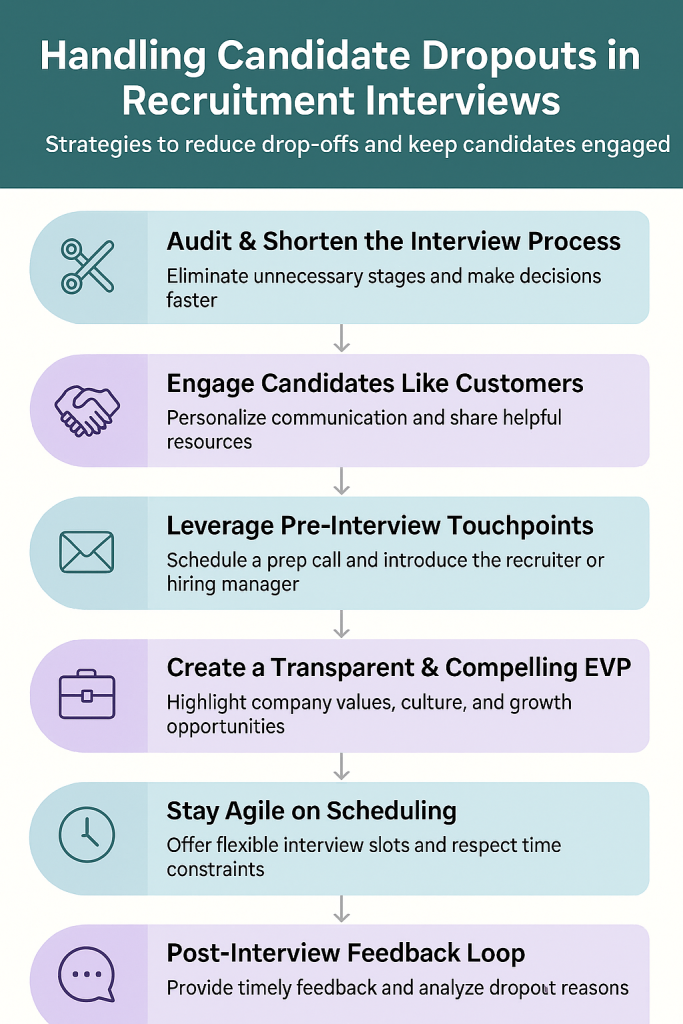
Discover why candidates drop out during the recruitment process and how to reduce interview drop-offs with proven TA strategies, engagement tips, and tech-enabled solutions.
🚨 The Dropout Dilemma
It’s a familiar scenario for recruiters: you identify the right candidate, schedule the interview, and… silence. No-show. Vanished. In today’s hyper-competitive job market, candidate dropouts during the interview stage have become increasingly common—and costly.
According to industry data, up to 37% of candidates drop out mid-interview cycle, often without warning. These dropouts don’t just delay hiring—they damage employer brand, demotivate hiring managers, and stretch already lean TA teams.
So what’s causing this? And more importantly—how can we fix it?
💡 Why Candidates Drop Out: Root Causes
Before we jump to solutions, it’s crucial to understand the “why.”
Here are the top reasons candidates ghost or withdraw from the process:
- Lengthy hiring timelines — Candidates lose interest or accept offers elsewhere
- Poor communication — Lack of timely updates or unclear expectations
- Interview fatigue — Too many rounds or repetitive questions
- Better offers — Higher compensation or brand prestige elsewhere
- Negative experience — Unprepared interviewers, unstructured process, or no feedback
- Lack of flexibility — Inflexible schedules or insistence on in-person interviews
✅ Proven Strategies to Reduce Candidate Dropouts
Here’s how you can proactively prevent dropouts and keep top candidates engaged throughout the funnel:
1. Audit & Shorten the Interview Process
✂️ Fewer rounds. More focused questions. Faster decisions.
- Eliminate unnecessary interview stages
- Combine panels where possible
- Empower hiring managers to decide within 1-2 days post-final round
Tip: Communicate the full interview structure upfront, including timelines.
2. Engage Candidates Like Customers
🤝 Think candidate NPS.
- Personalize communication at every stage
- Share helpful resources: team bios, culture videos, project previews
- Send reminders and confirm interview logistics clearly
Tools: Use CRM or ATS automation for timely follow-ups and nurture flows.
3. Leverage Pre-Interview Touchpoints
✉️ The journey starts before the interview.
- Schedule a quick pre-interview call to answer FAQs
- Share prep material or a “What to Expect” document
- Introduce the recruiter or hiring manager via email/video
4. Create a Transparent & Compelling EVP
💼 Why should they choose YOU?
- Highlight company values, team culture, growth opportunities
- Let candidates hear from employees—not just HR
- Showcase flexibility, DEI efforts, and upskilling programs
5. Stay Agile on Scheduling
⏰ Flexibility = Respect
- Offer multiple slots or asynchronous interview options when possible
- Use self-scheduling tools like Calendly
- Respect time zones and personal constraints
6. Post-Interview Feedback Loop
🗣️ Every candidate deserves a closure.
- Send timely feedback, even to rejected candidates
- Ask for feedback from those who drop out—politely and anonymously
- Track and report dropout patterns in your ATS
📊 Bonus: Create a Candidate Dropout Dashboard
Monitor:
- Stage-wise dropout rate
- Interview-to-offer ratio
- Response time per candidate
- Feedback scores on candidate experience
Platform Tip: Tools like Greenhouse, Lever, Zoho Recruit, or Power BI can help you build visual dashboards.
🚀 Final Thoughts: Think Experience, Not Just Process
Candidate dropouts aren’t just a scheduling issue—they’re an experience issue.
By thinking like a marketer, acting like a partner, and moving like a strategist, TA professionals can create a process that respects the candidate’s time, effort, and expectations.
In 2025 and beyond, candidate experience is your competitive edge.
#CandidateExperience #TalentAcquisition #HiringStrategy #RecruitmentTips #HRTech #CandidateEngagement #RecruitSmarter #PeopleFirstHiring #HRStrategy #FutureOfWork
